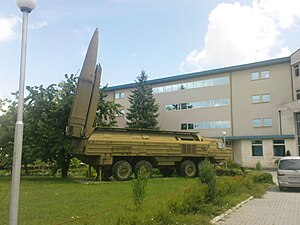OTR-23 Oka
| OTR-23 Oka SS-23 Spider | |
|---|---|
 An SS-23 Spider at the National Museum of Military History in Sofia, Bulgaria. | |
| Type | Tactical ballistic missile |
| Place of origin | |
| Service history | |
| Used by | See operators |
| Production history | |
| Designer | KBM (Kolomna) |
| Manufacturer | Votkinsk Machine Building Plant |
| Produced | Introduced 1980 |
| Specifications | |
| Mass | 4,360 kg (9,610 lb) |
| Length | 7.53 m (24.7 ft) |
| Diameter | 0.89 m (2 ft 11 in) |
| Warhead | Nuclear 50-100 kT, HE fragmentation, submunition, or chemical |
| Engine | Single-stage solid propellant |
Operational range | 500 km (310 mi) |
Guidance system | Inertial with terminal active radar |
| Accuracy | 30-150 m CEP |
Launch platform | Mobile TEL |
The OTR-23 Oka (Russian: OTP-23 «Ока»; named after Oka River) was a mobile theatre ballistic missile deployed by the Soviet Union near the end of the Cold War to replace the obsolete SS-1C 'Scud B'. It carried the GRAU index 9K714 and was assigned the NATO reporting name SS-23 Spider. The introduction of the Oka significantly strengthened Soviet theatre nuclear capabilities as its range and accuracy allowed it not only to strike hardened NATO targets such as airfields, nuclear delivery systems, and command centers, but moving targets as well. It also had a fast reaction time, being able to fire in approximately five minutes, and was nearly impossible to intercept, thereby allowing it to penetrate defenses[1].
The operational life of the Oka was limited and controversial. The Soviet military asserted that the Oka only had a maximum range of 250 miles (400 km). American experts on the contrary estimated it had a greater range. In 1987, Mikhail Gorbachev proposed to George Schultz that he would unilaterally remove all Okas, if it would prevent the United States from building up its own short-range nuclear forces in Europe, despite the fact that the Soviet military was in favor of the Oka. Schultz however lacked the authority to act on the suggestion.[2] Gorbachev included the Oka in the class of systems to be discontinued as part of the INF Treaty as a gesture of goodwill, even though Soviet assertions of its maximum range did not put it outside of the specifications of the treaty.[3]
There was diplomatic controversy over this weapons system in April 1990 when the Soviets informed the US of their covert transfer of at least 120 missiles to the Warsaw Pact states of Czechoslovakia, Bulgaria, and East Germany during the time of negotiation of the Intermediate-Range Nuclear Forces Treaty. Evidence indicates that the missiles were transferred with conventional warheads only, although equipment to load Soviet nuclear warheads was apparently retained.[4]
Missile Variants
- The 9M714V missile armed with the AA-60 (9N63) nuclear warhead and possessing a maximum range of 500km.
- The 9M714F missile armed with a FRAG-HE warhead weighing 450 kg and possessing a maximum range of 450km.
- The 9M714K missile armed with a submunitions warhead weighing 715 kg and possessing a maximum range is 300km.
In addition to these warheads, the SS-23 was also reported to be able to deliver chemical munitions.
Operators
 Soviet Union
Soviet Union- Eliminated as directed by the INF Treaty.
 East Germany
East Germany- Eliminated in the 1990s.
 Bulgaria
Bulgaria- Eliminated in 2002.
 Czechoslovakia
Czechoslovakia- Passed on to successor states.
 Czech Republic
Czech Republic- Eliminated in the 1990s.
 Slovakia
Slovakia- Elimination in 2000.
Notes
- ^ http://www.missilethreat.com/missilesoftheworld/id.142/missile_detail.asp MissileThreat :: SS-23
- ^ David Hoffman, The Dead Hand: The Untold Story of the Cold War Arms Race and Its Dangerous Legacy (Random House, 2009), 283-284.
- ^ Short-Range Ballistic Missile - OTR - 23 "Oka", EnemyForces.Net (accessed 19 August 2010).
- ^ http://www.fas.org/nuke/guide/russia/theater/ss-23.htm SS-23 SPIDER - Russian / Soviet Nuclear Forces
